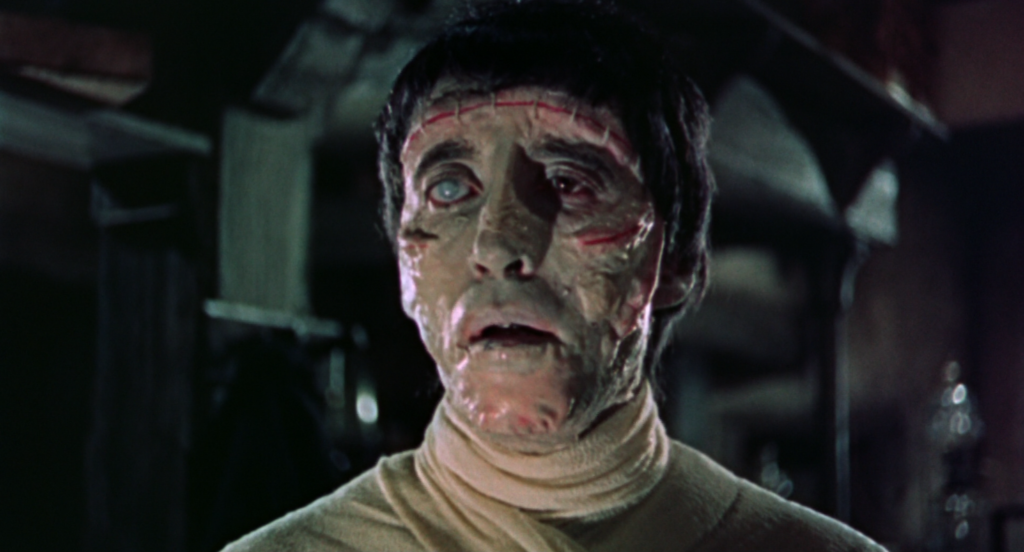
Horror – in color! The Curse of Frankenstein (1957), the first Hammer Gothic and the prototype for all future Hammer horror, proudly bore the British X certificate as had its breakthrough predecessor, The Quatermass Xperiment (1955), but now added a significant new element to the formula. Now you could see the red of the blood – as when Baron Victor Frankenstein (Peter Cushing), in slicing open a cadaver, wipes his hands carelessly on his fine shirt – a moment that would have passed without significance in black and white. By modern standards, one can see that quite a bit is left to the imagination. More often than not, the slicing and the sliced are just out of shot, leaving Cushing’s talented miming (and some well placed sound effects) to fill in the blanks – all to get past the censors. But even then, the dialogue paints a pretty picture. “Well the birds didn’t waste much time, did they?” Frankenstein tut-tuts over one body lurking just below the shot. “Half the head’s eaten away.” Then – though he swaddles it in his arms and keeps the hideous head out of sight – he drops it into an acid bath where it can dissolve into nothing. This was heavy stuff for 1957, when true horror had all but vanished in the drive-ins, replaced by tepid teenage B-movies and Atom Age science fiction.
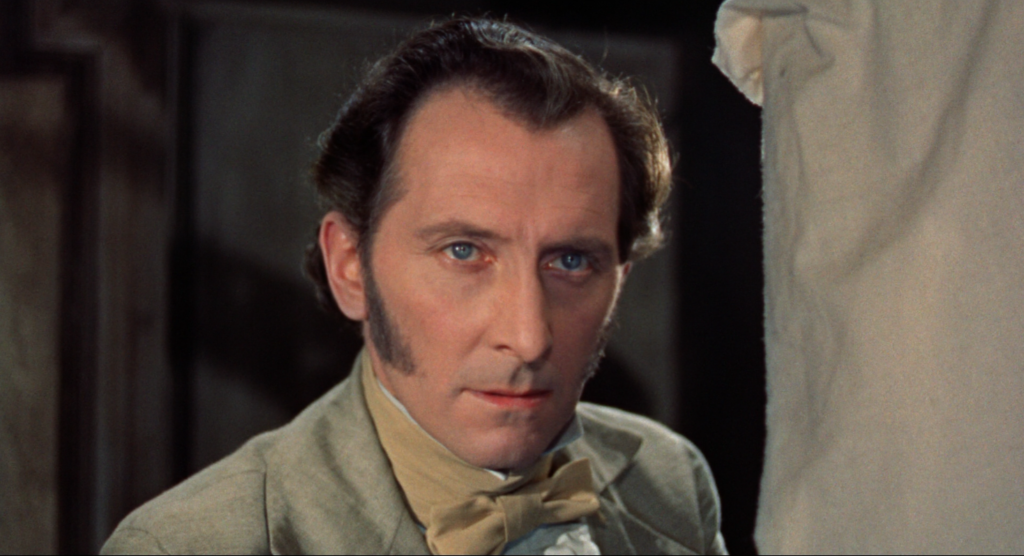
Peter Cushing as Victor Frankenstein
What’s more, despite all the grisliness, The Curse of Frankenstein looked like an A picture. It was still a low budget film, albeit with healthy financing and distribution from Warner Bros; Hammer had a knack for making a small budget go much further on screen. Filming at their cozy Bray Studios, a dream team organically came together to create a film to rival anything a major studio could conjure: producer Anthony Hinds, director Terence Fisher, screenwriter Jimmy Sangster, cinematographer Jack Asher, set designer Bernard Robinson, composer James Bernard – all delivering career-defining work. The only thing it lacked were major names. (Unlike Quatermass and many of their other black-and-white thrillers, with Curse Hammer didn’t lean on an American actor to secure a Stateside distribution deal.) Though Cushing was already well on his way to a prolific acting career, he and his “monster,” Christopher Lee, were not stars. The Curse of Frankenstein made them stars. In the long history of the horror film, this was a seismic event, reanimating Gothic horror like Cushing’s young upstart Frankenstein, upping the quotients of sex and violence in a rebellious assault on older sensibilities. Its follow-up, Dracula (aka Horror of Dracula, 1958), sealed the deal.
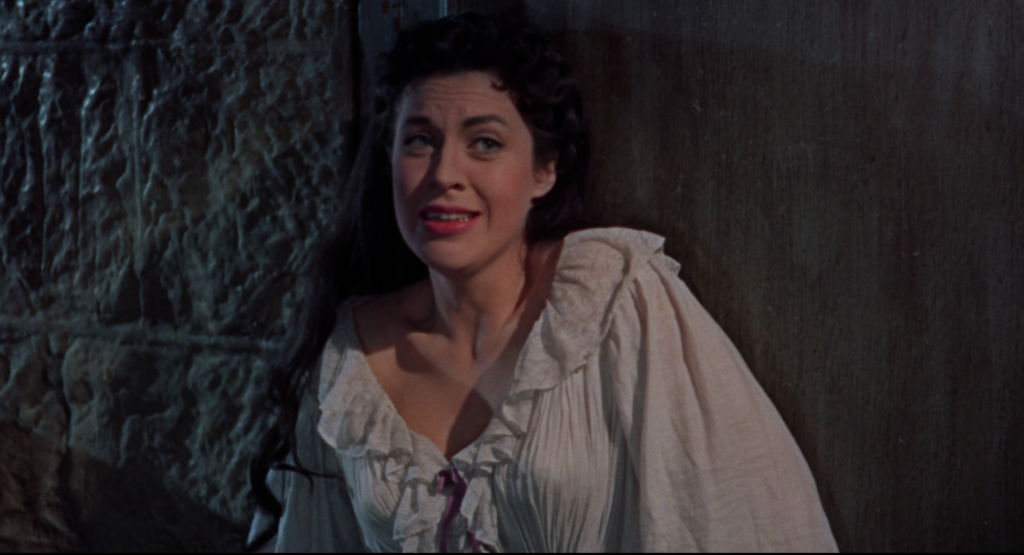
Valerie Gaunt as the maid Justine
Yet as a Frankenstein movie – one in a long line, even then – the key innovation is the sheer nastiness of the Baron. There’s something genuinely stomach-churning about the pleasant dinner Victor shares with his fiancée Elizabeth (Hazel Court) after he’s murdered his maid Justine, with whom he was having an affair. When Elizabeth asks after the maid’s fate, he smiles pleasantly and speculates that she’s eloped with some villager – “After all, she was always a romantic little thing.” We realize that a “thing” is all she ever was to him. Earlier, when he’s confronted by Justine over his broken promise to marry her, he’s disgusted at the revelation of her pregnancy – repulsed, as though this method of producing life is the vulgar one – and casually accuses her of sleeping with every man in the village (“Why choose me as the father?”). In previous films, Frankenstein’s worst sins are grave-robbing and his creature. Here he murders casually to meet his needs, making clear the irony of the film’s epilogue, as the Baron pleads to his captors to believe his story of the monster, ignorant of the fact that the monster’s existence is an insufficient alibi to the crimes to which he’s just confessed. Cushing is perfect in the role: by turns brilliant, charming, seductive, coldly logical, callous, and smug. Only in the final act is he driven to desperation and panic as his grand plan spectacularly unravels. Often overlooked but also deserving of praise is the performance of Robert Urquhart as his mentor and co-conspirator Paul Krempe, who only gradually realizes the dark trajectory of their work: “All right, you can’t see the horror of what you’re doing. At first I was blind to it.” (Cushing’s answer to Paul’s objections always brings a smile to my face: “Oh come on, Paul, you haven’t shown any scruples up till now!”)
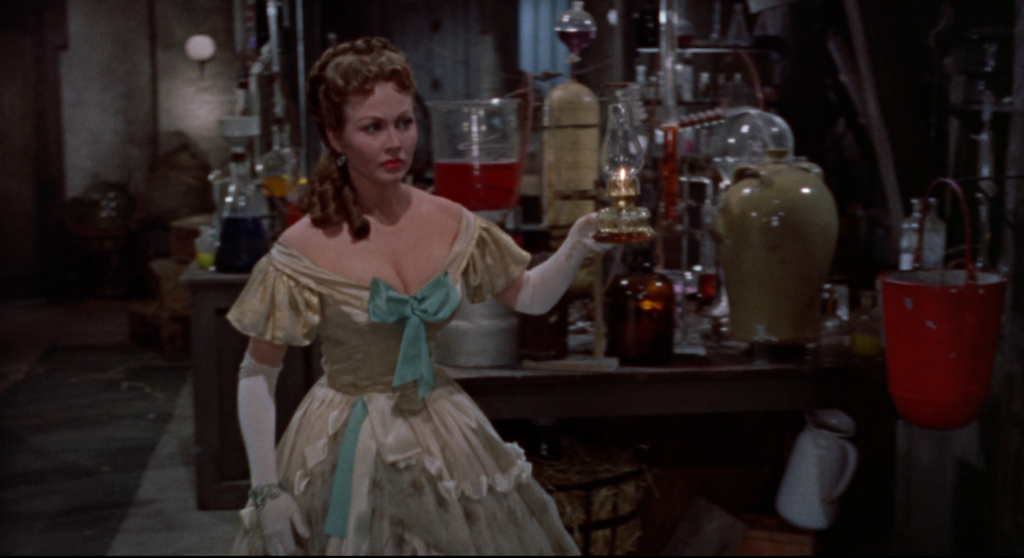
Elizabeth (Hazel Court) discovers Victor’s laboratory.
Phil Leakey provided the makeup, working under the big shadow cast by Jack Pierce. In contrast to Karloff, Lee performs his monster as a living rag doll manipulated by some invisible puppeteer. He stumbles clumsily and struggles to lift his head. He lifts his hands up in an imitation of the arms-extended monster caricature, but just as quickly they drop limply in front him. He has no squared-off head, but a mop of damp black hair above his jagged scars that looks even more unbecoming when it’s been half shaved following a second resurrection and some brain surgery. He looks, more than anything, assembled – carelessly, despite the Baron’s Nazi-like ambitions for creating the perfect human specimen. The grotesque design, much more realistically corpse-like than Pierce’s, further advances this film to stand on its own, and not to be seen in any way as a remake. In fact, it’s hardly even an adaptation, bearing little resemblance to Shelley’s book in Sangster’s efforts to subvert it – as with Hammer’s Dracula films, more elements of the source material would be sprinkled across sequels, including the idea of an intelligent monster. Yet there are nods to the original Frankensteins, from the use of electricity in reanimation to the presence of both a blind man encountering the creature and an innocent child kneeling before a lake – these two iconic Frankenstein moments brought together in one scene as the monster, efficiently, kills both characters. (The child’s death is implied. There were the censors to be dealt with at the end of the day, after all.)
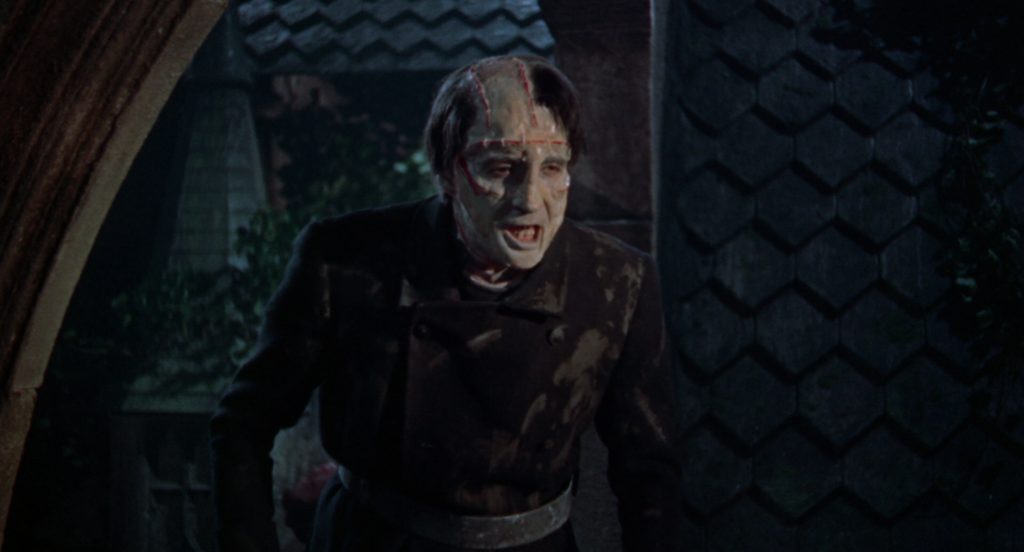
Christopher Lee as the Creature.
In 1957, much of this film must have seemed shocking or even crass; but the compelling direction of Fisher, the brilliant and pointed use of color, light, and darkness by Asher to enhance the storytelling, and the swirling romantic score of Bernard all act in concert to disarm viewers with more delicate sensibilities. It’s a poison pill, but it goes down smoothly. The new Blu-ray from Warner Archive is an important one, presenting a long-necessary (4K) restoration that brings back the lush color which is so central to the film’s impact. To silence all arguments over which is the proper aspect ratio, three are included (1.85:1, 1.66:1, and an open matte 1.37:1, though you may just want to stick with the first), along with a new audio commentary by Constantine Nasr and Steve Haberman, and featurettes diving into the film’s history and major players (including the welcome contribution of Little Shoppe of Horrors magazine’s Richard Klemensen). Here it is, the one that truly kicked off Hammer horror as we know and love, in a definitive presentation.










